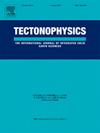Geodynamics of the Makran subduction zone inferred from relocated seismicity
IF 2.7
3区 地球科学
Q2 GEOCHEMISTRY & GEOPHYSICS
引用次数: 0
Abstract
The Makran Subduction Zone is unusual, with an ENE-WSW trending volcanic arc that is nonparallel to its ∼E-W trending accretionary prism. The discrepancy has been attributed to an eastward reduction of the subduction angle. To assess this theory, we relocated 146 moderate to large earthquakes in the region during the period 1968 to 2022. We found that in eastern Makran, the region with intermediate-depth earthquakes has a constant width of ∼180 km, with a trend sub-parallel with the trend of the volcanic arc. The fault planes of most of the normal-faulting intermediate-depth earthquakes are also parallel to the trend of the volcanic arc. These observations suggest an ENE-WSW trending subducting plate hinge and a constant subduction angle in eastern Makran. The ∼E-W trend of the intermediate-depth earthquakes in western Makran indicates an ∼E-W trending subducting plate hinge. We relate the different orientation of the plate hinges in eastern and western Makran to the different shape of the overriding plates. The cumulative Wadati-Benioff zone for eastern Makran shows a subduction angle of ∼15o in the depth range of ∼45–80 km, increasing to ∼45o at depths greater than 80 km. The significant component of strike-slip faulting of the intermediate-depth events in western Makran implies that the subducting plate in western and eastern Makran experience different stress regimes. Alignment of a considerable number of intermediate-depth earthquakes along narrow ENE-WSW lineaments implies a pre-existing weakness in the subducting plate.
由重新定位的地震活动推断的马克兰俯冲带地球动力学
Makran俯冲带是不寻常的,有一个ENE-WSW走向的火山弧,与它的~ E-W走向的增生棱镜不平行。这种差异归因于俯冲角向东减小。为了评估这一理论,我们重新定位了1968年至2022年期间该地区的146次中大型地震。我们发现,在马克兰东部,中深度地震区具有约180 km的恒定宽度,其走向与火山弧走向近平行。大多数正断层中深地震的断裂面也与火山弧走向平行。这些观测结果表明,马兰东部为ENE-WSW向俯冲板块铰链,俯冲角度恒定。马克兰西部中深度地震的~ E-W走向显示了一个~ E-W走向的俯冲板块铰链。我们将马克兰东部和西部板块铰链的不同方向与上覆板块的不同形状联系起来。马可兰东部的累积Wadati-Benioff带在~ 45-80 km深度范围内显示出~ 150°的俯冲角,在深度大于80 km时增加到~ 45°。马克兰西部中深度事件中走滑断裂的重要组成部分表明马克兰西部和东部俯冲板块经历了不同的应力状态。相当多的中深度地震沿狭窄的ENE-WSW构造线排列意味着俯冲板块中存在预先存在的弱点。
本文章由计算机程序翻译,如有差异,请以英文原文为准。
求助全文
约1分钟内获得全文
求助全文
来源期刊

Tectonophysics
地学-地球化学与地球物理
CiteScore
4.90
自引率
6.90%
发文量
300
审稿时长
6 months
期刊介绍:
The prime focus of Tectonophysics will be high-impact original research and reviews in the fields of kinematics, structure, composition, and dynamics of the solid arth at all scales. Tectonophysics particularly encourages submission of papers based on the integration of a multitude of geophysical, geological, geochemical, geodynamic, and geotectonic methods
 求助内容:
求助内容: 应助结果提醒方式:
应助结果提醒方式:


